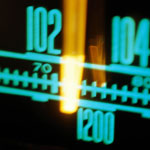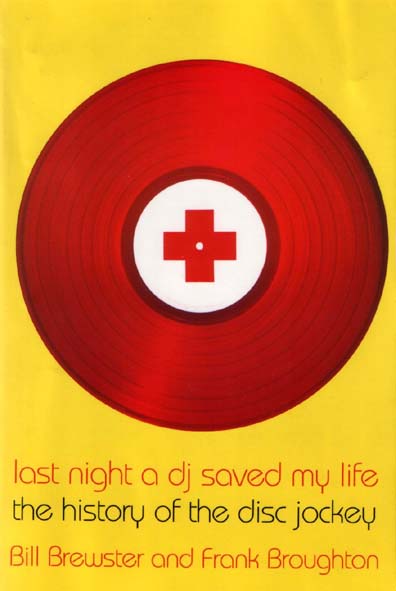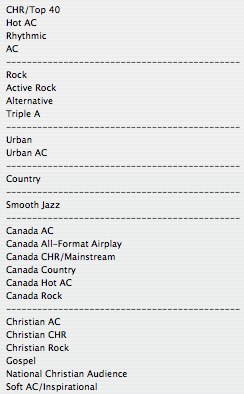Posts Tagged DMDS
On The Radio
Posted by Gavin Bradley in DJing, Labels, Publishing, Radio, Writing on August 12, 2009
Radio was initially a live medium of announcers, actors and orchestras. It wasn’t until the late 1920s that it became widely acceptable to play records on the air. A royalty system then had to be developed to pass on some of the income from the advertisers to the songwriters and musicians for their content.
Regulations were soon put in place (by the FCC in the United States and the CRTC in Canada) to cap the number of stations a parent company could own; to prevent the conflict-of-interest that would be brought on if record companies were to own radio stations and try to control what was played; and to ensure that radio DJs had a degree of freedom in selecting music they felt their audiences would enjoy or benefit from.
In the 50s a handful of radio DJs were paramount in breaking rock’n’roll. Late in the decade America began a federal investigation which effectively stamped out payola (the practice of record labels bribing DJs to promote specific singles), helping to cement the DJ’s role as trusted tastemaker, and eventually, provocateur. In the 60s radio DJs were key figures in a rising counterculture and the 70s brought FM radio, where jockeys had the freedom to present entire sides of albums in high quality stereo if they so chose.
Since the 80s, however, a series of policy and practice changes as a result of the mergers in big business have, in my view, pretty much castrated the radio DJ. Huge chains of stations are owned by single companies. Clear Channel monopolizes the U.S. with 1240 stations nationwide; Astral Media (the company behind Virgin Radio), CTV, Rogers and Corus Entertainment are the big ones in Canada.
DJs are handed playlists that they cannot stray from. (Actually the music is on hard disk now, and the next song on the list comes up in computer-selected order, eliminating the possibility for the DJ to stray.) Those playlists are determined by program directors who tend to add songs that are a) performed by established artists on major labels (because unfamiliarity would greaten the risk of listeners turning the dial and missing advertisements); b) no longer than 3:30 (because the shorter the songs, the more of them you can play between commercials); and c) rated highly by focus groups (who tend to react positively to songs that fit an immediately recognizable mold, ruling out many of the songs that would grow on people and promote change or growth in music).
Radio stations identify themselves by a particular ‘format’ – that is, they categorize themselves by the style of music they play. These formats are constantly in flux: if a chain of stations decides to alter what they’re playing and rename the format to appeal to a slightly different demographic, the rest of the stations in that format tend to follow suit. ‘Adult Contemporary’ used to mean Perry Como, and now it means Katy Perry––because it’s a format that plays music by the artists adults are listening to. (It’s also apparently on the verge of being renamed ‘Mainstream Soft’ to try to shake the Perry Como image.) A quick rundown of the formats:
- CHR – Contemporary Hit Radio/Top 40/Mainstream – for the tweens and teens, currently includes pop, dance and rap
- AC – Adult Contemporary/Mainstream Soft – for adults, including pop, rock, soul, dance that is quieter or a little slower
- Hot AC – for adults, but a little rockier or dancier
- Triple A – Adult Album Alternative – for 30-somethings looking for subdued album-oriented artists like A Fine Frenzy, Missy Higgins etc. – there are currently only 2 stations in Canada in this format, both on U.S. border towns
- Modern Rock – Punk pop, a la Sum 41 or Hedley
- CAR – Contemporary Album Rock – Rock, a la Nickelback
- Urban – the latest euphemism for ‘black music’ – Rap and R&B – there are no longer any urban stations in Canada as Toronto’s Flow 93.5 has changed to CHR
As well there are Jazz, Classical, Country and, in the U.S., plenty of Christian format stations listed by Nielsen:
Since songwriter(s) get paid anywhere from $1.65 to $25.86 per radio play (SOCAN’s payout rates depending on the station) you’re ideally hoping to get your single charting on as many formats as possible, as Jason Mraz recently did with ‘I’m Yours‘. It broke a record by hitting number 1 on the CHR, AC, Hot AC and Triple A charts.
The major labels feed their new singles to radio stations instantly through a digital delivery service (such as DMDS in Canada). Established artists’ singles get de facto rotation, newer artists get test spins. With such a closed system, now, how does a new independent artist get a song on the radio?
Generally, by paying an independent radio promoter to get it past the gates. Radio promoters have usually been in the industry, in various capacities, for a while…long enough to develop relationships with program directors at the key stations. In a sense, radio promoters have supplanted DJs as the tastemakers because they are relied upon to do quality control on the material they pass through. In another sense, however, they have their hands tied just as much as anybody else in the chain: nothing over 3:30, big chorus hook, no long intro without a vocal…all of the same rules apply. There is not much chance that a radio promoter is going to be able to sneak through something utterly genre-busting by an unknown artist.
Expect a radio promoter to charge $3000-$5000 to take on your single, send it digitally to the stations in the format that supports your genre of music, and then follow up with the stations’ program directors by phone and e-mail for a 3-month period.
In English-speaking Canada, some of the most successful radio promoters include Toronto’s Dulce Barbosa (who graciously educated me about radio formats recently), Dale Peters (also in Toronto) and Oscar Furtado (in Vancouver).
Further words about Canada: federal CanCon (Canadian Content) laws exist here to ensure that our own homegrown music is promoted at radio. So, 35-40% of the material Canadian radio stations play must fulfill two of the following ‘MAPL’ designations:
- M – Music – The music was written entirely by Canadians
- A – Artist – The recording was performed entirely by Canadians
- P – Production – The recording was made entirely in Canada
- L – Lyrics – The lyrics were written entirely by Canadians
I used to feel that CanCon laws skewed my perception of what was really going on in the world––that radio play should simply be awarded to the best songs by the most polished artists––and I resented the fact that some of the artists Canadian radio had led me to believe were bonafide ‘stars’ hadn’t even scratched the public’s consciousness anywhere else in the world. But I appreciate the unique contributions Canadian musicians have made on the world stage…contributions that were possible in part because they were at first protected here by CanCon laws next to the more powerfully promoted American and British artists. We are roughly 10% the population of the United States, so labels down there have 10 times the selection when looking for an artist to promote. This also means Canadian labels have roughly 10% of the budget their American counterparts get to throw behind their artists’ promotional plans. CanCon laws are a necessity.
The burning question of the moment, however, is how much radio play even matters to an artist’s success these days. In an age when music is increasingly discovered virally on the internet in blogs and links to YouTube sensations posted on Facebook, less people spend time waiting around for a song to come on the radio. Even fewer seem to be sitting around watching music video channels. However one unique feature radio does provide is a linear, programmed stream of music and news that can be enjoyed in the background while at work or in the car, not to mention that bit of human presence the hosts bring. So for the time being, new songs will continue to be broken at radio and songwriters will continue to profit from broadcast. For the independent artist, it’s a question of whether investing in an independent radio promoter will pay off short-term, financially, or in the endgame of building a fanbase.
It is possible to do the legwork yourself, getting your single heard by individual station managers or programmers in hopes that they’ll put it into rotation and, best case scenario, cause a domino effect with other stations. But if you want to hit everybody at once and stay on top of the stations, it’s best to get serious and hire a radio promoter.
A Fine Frenzy, Dale Peters, DMDS, Dulce Barbosa, Hedley, Jason Mraz, Katy Perry, Missy Higgins, Nickelback, Oscar Furtado, Perry Como, Sum 41
-
-
Archives
- April 2013 (1)
- August 2011 (1)
- November 2010 (1)
- August 2010 (3)
- July 2010 (1)
- March 2010 (1)
- January 2010 (1)
- November 2009 (1)
- October 2009 (2)
- September 2009 (1)
- August 2009 (1)
- July 2009 (4)
- June 2009 (7)
- May 2009 (10)
-
Meta



